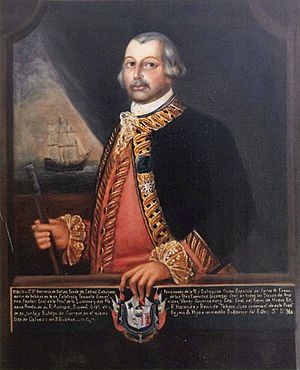Copano, Texas facts for kids
Copano (also known as El Copano) is a ghost town in Refugio County, Texas. It sits on the northwestern shore of Copano Bay, about 5 miles (8 km) north of today's Bayside. This place was once a very important port, the first of its kind in South Texas.
The Spanish founded Copano in the early 1700s. They named it after the Copane Indians, who lived in that area. At first, it was a secret spot for smugglers and pirates. But in 1785, the Spanish government officially opened it as a port. The town was left empty in the 1880s, after the area became more settled following the Texas Revolution. Today, you can still find some old ruins of the town. However, these ruins are slowly falling into Copano Bay.
Contents
History of Copano
Early Port Use

After it was founded, El Copano was a popular spot for pirates and smugglers. In 1785, Bernardo de Gálvez y Madrid, Count of Gálvez, a powerful leader in New Spain, officially opened it as a port for people entering Texas. Back then, there wasn't much on land, just a customs house and a water tank. But the port itself was very valuable.
In 1834, General Juan Almonte inspected the port for Antonio López de Santa Anna. He said it was the deepest port on the Texas coast. People also called it the "safest" port because Copano Reef protected it. Many Irish settlers used Copano from 1828 to 1835. They landed there on their journey from New York City to the Irish colony of San Patricio. Sadly, at least 200 of these settlers died from cholera when they arrived. They were buried on Copano Beach.
Copano During the Texas Revolution
During the Texas Revolution, both the Mexican and Texian armies used the port. In September 1835, Mexican General Martín Perfecto de Cos landed at Copano. He was on his way to the missions in San Antonio and Goliad.
The Texians made the port stronger the next month. They used it to bring in food and supplies. But in March 1836, Mexican General José de Urrea captured it. The Mexicans kept control of the port until the war ended. They used it to get more soldiers and send injured people and prisoners to Mexico. After the war, Texian Major Isaac Burton and the Texas Rangers captured several Mexican ships, soldiers, and supplies.
Building a Settlement
In 1825, James Power and James Hewetson received land to create an Irish and Mexican settlement. This land was between the Lavaca River and the Nueces River. However, in 1828, the area was made smaller. It only included land between the Guadalupe River and Lavaca. This change was reversed in 1829. But arguments over land and fighting between Texians and Mexicans stopped any settlement attempts at Copano.
After Texas became independent from Mexico, James Power started a permanent settlement at Copano in 1836. Joseph E. Plummer's house was likely the first of about a dozen homes built there. These homes were made using a special concrete from oyster shells found on Copano Beach. Power himself was building a two-story house before he passed away in 1852.
A school and a post office were also built. The post office was used until 1864. Three docks were built on the bay. These docks helped traders bring goods like cotton, animal hides, and animal fat, which made the settlement successful.
Decline of the Town
Copano continued to do well during the American Civil War. Other ports were blocked by Union forces, but Copano's location helped it avoid being noticed. This changed in 1864 when a Union fleet anchored near Copano. This caused the settlers to leave for several days.
After the war, there were problems. Attempts to build railroads to Goliad and San Antonio failed. It was also hard to get enough fresh water. Because of these issues, most settlers moved to Refugio. By 1888, the town was completely abandoned after several strong hurricanes hit the area.
What Remains Today
You can reach the ruins of Copano by boat from the shore of Bayside. However, the land is private property, owned by the families of the original settlers. A historical marker was placed at the site in 1936. But in 1978, a storm almost made it fall into Copano Bay. So, it was moved 5 miles (8 km) south to Bayside Park.
In 2005, a study by TAMU Kingsville found a water tank and 10 shellcrete homes on the edge of a cliff. The study warned that these ruins would soon fall into the bay. They noted that the shoreline had moved back 100 feet (30 m) since 1935. It is believed that the Plummer residence has already sunk to the bottom of the bay. Copano is now considered one of Texas's most endangered historical sites.
See also
In Spanish: Copano (Estados Unidos) para niños

